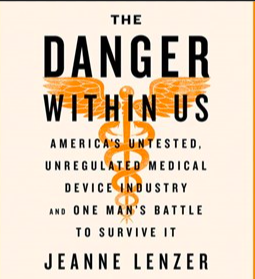The New York Times published this article last month. It tells the story of how orthopaedic implants can get 'cleared' by the FDA for use in patients without rigorous studies of their safety or effectiveness. But rather than just reading the article, we strongly recommend that you read the book from cover to cover:
The author tells the story of an orthopaedic surgeon who had a colleague treat his hip arthritis using a metal-on-metal hip.
Five years after his surgery he underwent a second surgery to have the device replaced. When his surgeon opened his hip, what he found a condition called "metallosis" in which metal debris had damaged local muscle and bone. In addition there was evidence that metal ions from the hip were affecting the function of his heart and brain. Over 9,000 patients had complications related to these implants. The device was recalled by the company in 2010 (see this link).
Of course, "recalling" a defective device implanted in thousands of people is a much bigger deal than recalling a car with a defective airbag (see this link).
Should all patients with 'recalled' devices have them removed? Who should pay for the costs and cover the risks of such a revision surgery?
The author points out (and we quote) that the public "assumes that the Food and Drug Administration requires rigorous testing of medical devices before they are approved, the same as the lengthy approval process it requires for new drugs. In fact, most high-risk devices on the market, including implants, have undergone no clinical testing at all.
Although the standard for approval of a new drug usually calls for two randomized, controlled clinical trials, the standard for many medical devices is no standard at all. Since medical devices didn’t come under regulatory control by the F.D.A. until 1976, the agency simply grandfathered in all devices that were already on the market under a provision known as 510(k), which allows manufacturers to sell most new devices without requiring any clinical testing as long as the manufacturer says its product is “substantially equivalent” to an existing device.
In addition to the 510(k) pathway, medical device companies can avoid clinical testing for the highest risk devices through the supplement pathway by telling the F.D.A. they made a minor change to a previously approved device."
Comment: As orthopaedic surgeons, we are frequently presented with new implants that have just arrived on the marketplace, most of which have been 'cleared' by the 510(k) process because they are stated to be 'substantially equivalent' to a previously marketed device. However, these new devices cannot be 'completely equivalent' to implants that are currently available (otherwise they could not be patented and successfully marketed). The gap between 'substantial' and 'complete' equivalency allows for unexpected results and unanticipated complications as well as new technical challenges in implanting the new system.
A recent article, Analysis of FDA-Approved Orthopaedic Devices and Their Recalls, (see this link), points out that the recall rate was 17.8% for 510(k)-cleared devices. Those authors concluded that: "given that 510(k)-cleared devices were 11.5 times more likely to be recalled than PMA-approved devices, it is concerning that most orthopaedic devices are cleared through the 510(k) process with limited clinical trials data."
Thus, when considering a new device, we need to ask "how does this differ from what is currently in common use?" and "what are the potential adverse outcomes that might result from these differences".
Finally, it seems that we should push for a better definition of "substantial equivalency'. Different bearing surfaces, different articular surface shapes, different materials, different fixation systems, and different degrees of modularity do not seem to us to be 'substantially equivalent'. Patient safety would seem to be served by a closer examination of systems that are not, in fact, substantially equivalent.
=====
Finally, it seems that we should push for a better definition of "substantial equivalency'. Different bearing surfaces, different articular surface shapes, different materials, different fixation systems, and different degrees of modularity do not seem to us to be 'substantially equivalent'. Patient safety would seem to be served by a closer examination of systems that are not, in fact, substantially equivalent.
=====
You can support cutting edge shoulder research that is leading to better care for patients with shoulder problems, click on this link.
Follow on twitter: https://twitter.com/shoulderarth
Follow on facebook: click on this link
Follow on facebook: https://www.facebook.com/frederick.matsen
Follow on LinkedIn: https://www.linkedin.com/in/rick-matsen-88b1a8133/
Here are some videos that are of shoulder interestShoulder arthritis - what you need to know (see this link).How to x-ray the shoulder (see this link).The ream and run procedure (see this link).The total shoulder arthroplasty (see this link).The cuff tear arthropathy arthroplasty (see this link).The reverse total shoulder arthroplasty (see this link).The smooth and move procedure for irreparable rotator cuff tears (see this link).Shoulder rehabilitation exercises (see this link).
Follow on twitter: https://twitter.com/shoulderarth
Follow on facebook: click on this link
Follow on facebook: https://www.facebook.com/frederick.matsen
Follow on LinkedIn: https://www.linkedin.com/in/rick-matsen-88b1a8133/
Here are some videos that are of shoulder interest
Shoulder arthritis - what you need to know (see this link).
How to x-ray the shoulder (see this link).
The ream and run procedure (see this link).
The total shoulder arthroplasty (see this link).
The cuff tear arthropathy arthroplasty (see this link).
The reverse total shoulder arthroplasty (see this link).
The smooth and move procedure for irreparable rotator cuff tears (see this link).
Shoulder rehabilitation exercises (see this link).



